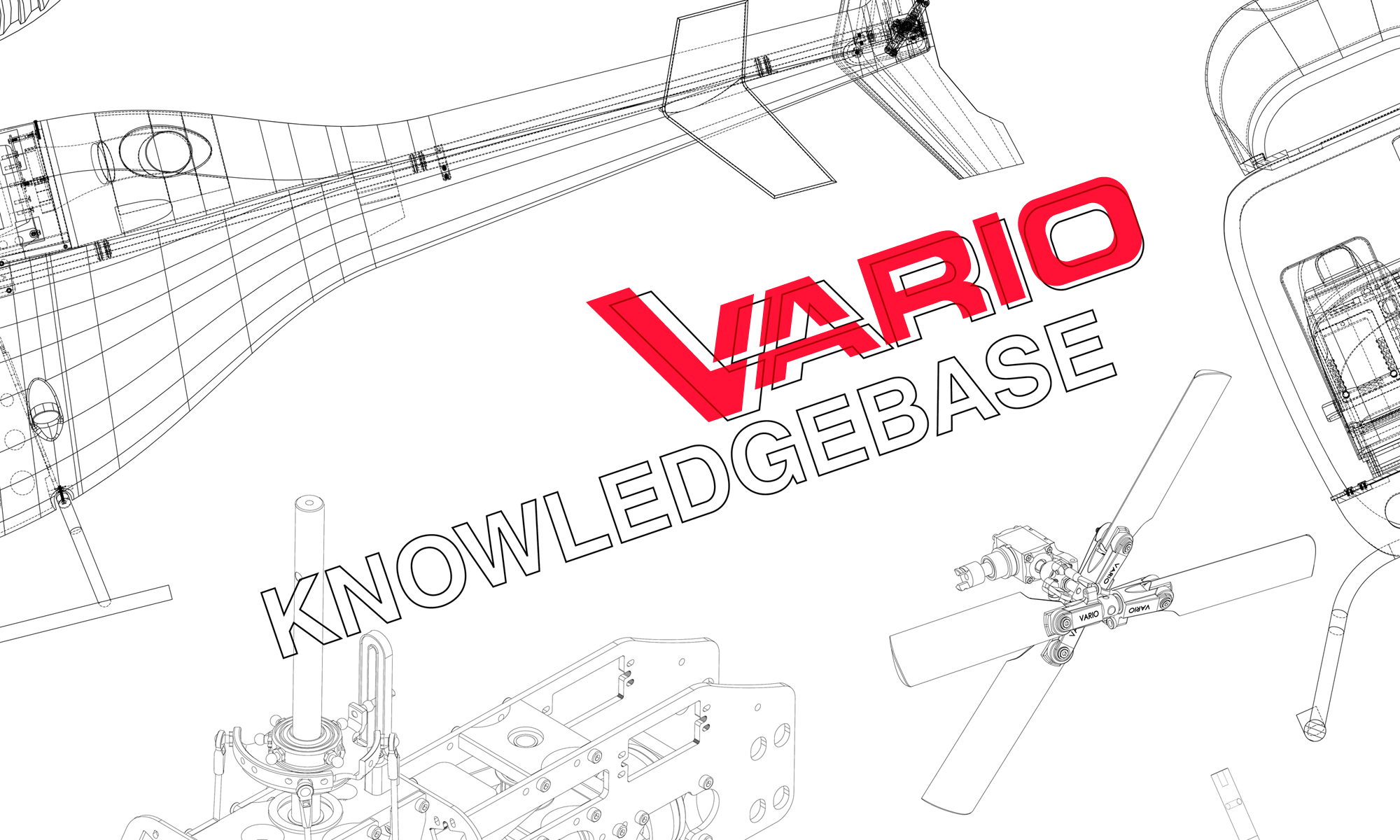The aluminum tail rotors for 6 mm tail rotor shaft (Vario Ord. No. 1003/80ff.) can be used universally. For example, tail rotor Ord. No. 1003/85 can be mounted on the left and right and used in both directions.
The directions of rotation can be achieved via the mounting position or direction of the bevel gear on the tail rotor shaft. No additional parts are required as the corresponding surfaces are already present on the shaft.
The linkage lever is also available in left and right versions:
- Right, plastic 97/30
- Left, plastic 97/10
- Right, aluminum 97/16
- Left, aluminum 97/15
Aluminum is recommended for turbine models due to the hot exhaust gases from the turbine or when high control forces are present. The aluminum version is stiffer.
There are different tail rotor shafts for the necessary adjustment of the center of the control travel. They differ in length by 5 mm so that different basic pitch angles can be achieved for torque compensation.
The plastic tail rotor (Ord.No. 1003/10, for Skyfox, left-turning tail rotor, upper blade turns to the rear) and the scale tail rotor of the Starwood Lama (Ord.No. 1003/84) are different. Here the tail rotors are not universally usable.
The Vario aluminum tail rotors for 5 mm tail rotor shaft (Ord. No. 1003/50 and 1003/51 ff.) are supported on the opposite side by a snap ring and a groove provided for this purpose. If the bevel gear is placed on the other side, the snap ring can no longer fulfill its actual function. A spacer bushing (Ord. No. 94/2) is then used. In contrast to the 6 mm tail rotor, joints of different lengths are available for adjusting the basic angle of attack for torque compensation (Ord. No. 100/10, 100/20 and 100/30).
Vario has further control bridges for 3- or 4-blade tail rotors, also in aluminum and also for the 6 mm tail rotor.
Here is the link to all our control bridges:
Vario Online Shop
GERMAN:
Die Alu-Heckrotoren für 6 mm Heckrotorwelle (Vario Ord.No. 1003/80ff.) sind universell einsetzbar. So kann beispielsweise Heckrotor Ord.No. 1003/85 links und rechts montiert und in beide Laufrichtungen verwendet werden.
Die Laufrichtungen lassen sich über die Montageposition bzw -richtung des Kegelzahnrades auf der Heckrotorwelle erreichen. Es sind keine weiteren Teile erforderlich, die entsprechenden Flächen sind bereits auf der Welle vorhanden.
Auch den Anlenkhebel gibt es in linker und rechter Ausführung:
- Rechts, Kunststoff 97/30
- Links, Kunststoff 97/10
- Rechts, Alu 97/16
- Links, Alu 97/15
Aluminium ist empfohlen für Turbinenmodelle wegen der heißen Abgase der Turbine bzw. wenn hohe Steuerkräfte vorhanden sind. Die Aluminiumversion ist steifer.
Für die notwendige Anpassung der Mitte des Steuerweges gibt es unterschiedliche Heckrotorwellen. Sie unterscheiden sich in der Länge um 5 mm, sodass unterschiedliche Grundanstellwinkel zum Drehmomentausgleich erreicht werden.
Beim Kunststoff-Heckrotor (Ord.No. 1003/10, für Skyfox, linksdrehender Heckrotor, oberes Blatt dreht nach hinten) und beim Scale-Heckrotor der Starwood Lama (Ord.No. 1003/84) ist es anders. Hier sind die Heckrotoren nicht universell verwendbar.
Die Vario Aluminium-Heckrotoren für 5 mm Heckrotorwelle (Ord.No. 1003/50 und 1003/51 ff.) werden über einen Sprengring und eine dafür vorgesehene Nut auf der Gegenseite abgestützt. Setzt man das Kegelzahnrad auf die andere Seite, kann der Sprengring seine eigentliche Funktion nicht mehr erfüllen. Es kommt dann eine Abstandsbuchse (Ord.No. 94/2) zum Einsatz. Für die Anpassung des Grundanstellwinkels zum Drehmomentausgleich gibt es – im Unterschied zum 6 mm Heckrotor – unterschiedlich lange Gelenke für die unterschiedlichen Steuerbrücken erhältlich sind (Ord.No. 100/10, 100/20 und 100/30).
Vario hat weitere Steuerbrücken für 3- oder 4-Blatt-Heckrotoren, auch in Aluminium und auch für den 6 mm Heckrotor.
Hier der Link zu all unseren Steuerbrücken:
Vario Online Shop
